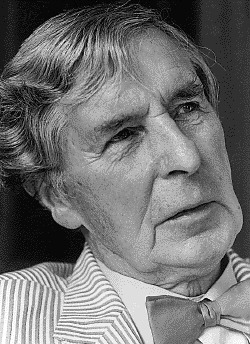In Celebration of the Human Voice - The Essential Musical Instrument
Home | Doo Wop | Barbershop | World | Contemporary | Christian | Vocal Jazz | Choral | Christmas | Instructional | Arrangements
Classical | Opera | Musicals | Personality | Young Singers | Disney | Videos | Songs | The Artists

Michael Tippett Biography

Click Here for Sheet Music and Songbook Vocal Arrangements
(Born; London, 2 Jan 1905)died 1998. English composer. He studied with C. Wood and Kitson at the RCM (1923-8), then settled in Oxted, Surrey, where he taught, conducted a choir and began to compose. However, dissatisfaction with his technique led him to take further lessons with Morris (1930-32), and he published nothing until he was into his mid-30s. By then he was conducting at Morley College, of which he became music director in 1940; there he performed his oratorio A Child of our Time (1941), which uses a story of Nazi atrocity but draws no simple moral from it, concluding rather that we must recognize within ourselves both good and evil. Earlier works, like the String Quartet no.1 and the Concerto for double string orchestra, had married Stravinskian neo-classicism with a bounding rhythm that came from the English madrigal, but the oratorio added to these a Baroque concept of form and black spirituals to replace the chorales of a Protestant Passion. It also made clear Tippett's willingness to exert himself in the public world, which he did again as a conscientious objector in 1943 in accepting imprisonment rather than conscription. A Child of our Time seems further to have released creative energy that went into a series of works - two more quartets, the cantata for tenor and piano Boyhood's End and the Symphony no.1 - leading to the composition of the opera The Midsummer Marriage in the years1946-52. This, at once a pastoral, a modern morality and a mystery play of psychic growth, called for a further extension of resources: luminous static harmony, orchestral brilliance, a bold command of large spans of time, and a lively variety of rhythm in the largely danced middle act. The message is again that of the oratorio: before marriage the central characters must each accept the wedding within their personalities of intellect and carnality. The theme relates to The Magic Flute, and Tippett's sources for his own libretto also include Shaw, Yeats and Eliot. The opera's musical exuberance spilt over into succeeding works, including the Fantasia concertante on a Theme of Corelli for strings and the Piano Concerto, but then through the Symphony no.2 (1957) came a clearing and hardening of style towards the vivid block forms and declamatory vocal style of the opera King Priam, composed in1958-61, which concerns the problem of free will. Once more an opera had its offshoots; notably in the Piano Sonata no.2 and the Concerto for Orchestra, with its distinct gestures and circular formal schemes, but followed by a new, ecstatic continuity in the cantata The Vision of St Augustine (1965). Here the baritone's central narrative is subverted by huge choral parentheses, representing the density of thought and feeling embracing the simple account of the circumstances leading up to the vision. In his opera The Knot Garden (1970) he concentrates on the emotional substance of clashes of personality and their outcome. His unusually candid if stylized presentation of raw human relationships and of the need to make a success of the seemingly incompatible ones produce a score of lapidary compression, notable for its metallic sonorities, its use of a 12-note theme (though not serial technique) to represent fractured relationships and its revival of blues and boogie-woogie in a manner analogous to his use of spirituals in A Child of our Time. Symphony no.3 continues to explore the seemingly inexhaustible flow of invention stimulated by the 'light' and the 'shadow'; the abstract musical argument of the first part is answered by the overtly human involvement of the second, where blues again express a basic human predicament and Beethoven's music provides archetypal gestures. The range of reference is wider in the opera The Ice Break, where again the blues stand for human warmth in a time of uncertainty but where the composer alludes to diverse strands of high and popular culture in a work that depicts and transfigures clashes of age, race and milieu. Again, the opera is composed of fragmentary scenes in which archetypal characters confront one another, but now in a context of global discord; the musical style is even more jaggedly kaleidoscopic, as it is also in the Fourth Symphony, which abandons the vocal solution of the Third but finds in purely musical development a metaphor of physical birth, growth and dissolution. Other late works include the full-length oratorio The Mask of Time (1982), a grand restatement of Tippett's musical and philosophical concerns, as well as a Concerto for string trio and orchestra. |
Select a Category |
Want to Sing? - Find a Chorus Near You
List of Choruses by State | List of Choruses by City
